 The third or fourth time I watched Nosferatu (1922) on a big screen, sometime in the late 1980s I think it was, it played in the old Neptune movie palace with Neptune's green-glowy eyes staring down on me from above the screen. Accompanying the film was a live musical performance by San Franscisco's Club Foot Orchestra. The third or fourth time I watched Nosferatu (1922) on a big screen, sometime in the late 1980s I think it was, it played in the old Neptune movie palace with Neptune's green-glowy eyes staring down on me from above the screen. Accompanying the film was a live musical performance by San Franscisco's Club Foot Orchestra.
Now silent films were shot to be shown at a different speed than modern projectors use, which is why so many screenings give the impression that everyone moved a little faster than they do nowadays, & blinked their eyes too fast. And this jazz group had concocted an absolutely horrible musical piece that underscored any speeded-up images.
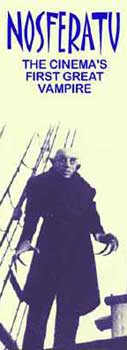 As Harker is taken to the mountain castle in a devil's carriage, the Club Foot Orchestra gave it a rapid tinky-tinkle score more suited to Tom & Jerry cartoons. As Harker is taken to the mountain castle in a devil's carriage, the Club Foot Orchestra gave it a rapid tinky-tinkle score more suited to Tom & Jerry cartoons.
I wished I were some all powerful empress who could have had the whole band shot, as they were destroying any opportunity for a good film experience.
I recently revisited the film on dvd with a generic & even more annoying organ accompaniment. I didn't quite have the nerve to turn the sound off completely, as chances are organ accompaniments were just this bad even in 1922.
This wonderful silent classic starts off slowly but once Jonathan Harker (renamed Hutter in some versions for copyright reasons, & played by Gustav von Wangenhein) reaches the castle in the Carpathians, Nosferatu is endlessly strange, beautiful, & creepy.
The familiarity of the Bram Stoker tale means a simplified adaptation has no suprises, even if a viewer hadn't seen this particular version numerous times already. Yet the otherworldliness of the shadowy images makes for a unique thrill that for me has never become dated or tiresome.
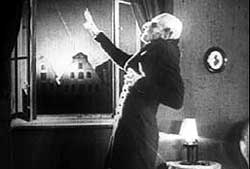 Nor is subtlety a hallmark of silent movies generally, & Max Schrek as Dracula (renamed Graf Orlok) could no more pass for human than could a giant rat, which he in part seems to be. Nor is subtlety a hallmark of silent movies generally, & Max Schrek as Dracula (renamed Graf Orlok) could no more pass for human than could a giant rat, which he in part seems to be.
Schreck's is, however, one of the greatest of all monster make-ups. Every scene that features his pallid bat-eared face or his gaunt silhouette is like an aesthetic demon portrait, all the more horrific for being lovely.
Renfield (Alexander Granac) who helps get Dracula from the Carpathians to civilization (to the German town of Bremen rather than Stoker's London) is a total wackjob hugely & wonderfully overplayed, looking like a combination Ebenezer Scrooge & the Cheshire Cat. Even Van Helsing (renamed professor Bulwer, played by John Gottowt) is parodic with extremeness, lecturing about carnivorous plants being the vampires of the plant world.
Yet it all comes off more as extravagant mummery, not mere clownishness, slowly building to an incredible visual climax. The heroic Nina Harker (as the English cards designate this combination of the novel's characters Lucy & Mina, & in the German cards renamed Ellen Hutter, played by Greta Schroeder) tricks Dracula by her pure heart into remaining at her bed until after cock's crow. When he confronts his fate, he is like a tricked animal, equal parts pitiful & frightful.
F. W. Murnau's Nosferatu is unquestionably one of cinema's great achievements, the influence of having never faded.
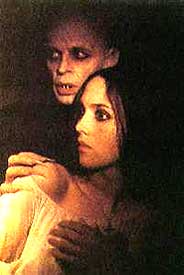 Werner Herzog's remake of Nosferatu (1979) is artful but a bit dull, & improves the storyline which was too simplified in Murnau's film. All the best bits, however, are taken from the b/w silent classic. Although I can see the silent film again & again, the remake for me holds up less well with repeat viewing. Werner Herzog's remake of Nosferatu (1979) is artful but a bit dull, & improves the storyline which was too simplified in Murnau's film. All the best bits, however, are taken from the b/w silent classic. Although I can see the silent film again & again, the remake for me holds up less well with repeat viewing.
I do love Klaus Kinski & it was wonderful to see him in Max Schreck's make-up. Kinski definitely understood the animalistic anguish of the monster & in particular takes the final scene a bit further than in the original, slowly, agonizingly chewing the scenery, & the heroine's neck. it even so remains an imitation of Max Schreck.
Since the power of the film is imagist & centers around the rat-like vampire, & Kinski does it mainly as an imitator of the original, it's hard to too much praise Herzog's Nosferatu even though it is in fact a very fine film. Had Herzog not dwelt so utterly in Murnau's shadow, it would merit high marks. Herzog for example heightens the bleak strange mood of the Castle interiors.
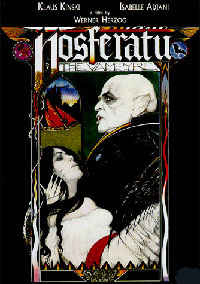 Bruno Ganz as Jonathan Harker is way more interesting in this version, & Isabella Adjani as Lucy Harker (again compounded with Mina) is way more thrilling & sexy than was Greta Schroeder in the role as Nina/Ellen. Bruno Ganz as Jonathan Harker is way more interesting in this version, & Isabella Adjani as Lucy Harker (again compounded with Mina) is way more thrilling & sexy than was Greta Schroeder in the role as Nina/Ellen.
Good though all the subsidiary ingredients are, however, Kinski adheres too much to Schreck's performance, & I fear it would only seem tremendously well done to whoever never saw Schreck do it first.
Kinski does treble the sexual undertones which are very muted in the 1922 version. It is otherwise as if Schreck were Elvis & Kinski an Elvis impersonator. Or more precisely, like Schreck was a real vampire (as Murnau was delighted to hear rumored) whereas Kinski is only pretending to be one.
Even so, as an imitation of a masterpiece, Herzog's remake comes closer to being itself a masterpiece than any similar remake such as Gus van Sant's slavishly copied Psycho (1998), John Moore's unnecessary update of The Omen (2006), or Jan de Bont's carnivalesque The Haunting (1999), each inferior to moodier more effective originals.
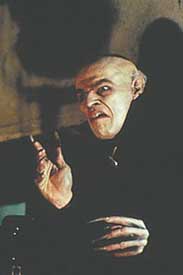 A vastly more original homage to Murnau's film is Shadow of the Vampire (2000) in which Willem Dafoe duplicates the Max Schreck make-up. A vastly more original homage to Murnau's film is Shadow of the Vampire (2000) in which Willem Dafoe duplicates the Max Schreck make-up.
Shreck on the set of Nosferatu was never seen by other cast members except in character, & his method-acting behavior unsettled the rest of the cast & crew, though encouraged by Murnau.
Upon this thread of fact rumors arose that Schreck didn't actually wear make-up, but Murnau had hired an authentic vampire to play the role, much as the village streets & the count's castle were real places, & not mere sets.
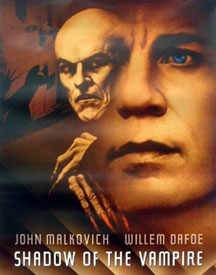 Shadow of the Vampire assumes that the rumors about Max Schreck were true. Shadow of the Vampire assumes that the rumors about Max Schreck were true.
John Malkovich as Fredrich Murnau shows up at Count Orlock's castle with his cast, crew, & equipment, & struggles to keep the vampire from sucking dry too many members of the team while attempting to finish the shoot.
To control Orlock & get the performance he desires, Murnau has promised him that he can drink the blood of the leading lady (Catherine McCormack as the actress Greta Shroeder) in the final scene.
Both Dafoe & Malkovich turn in sinister, thrilling, & funny performances, & Dafoe in particular is delicious.
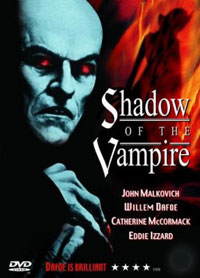 He takes the character created by history's Max Schreck & gives him another, fuller existence apart from the film in which Murnau has cast him. He takes the character created by history's Max Schreck & gives him another, fuller existence apart from the film in which Murnau has cast him.
Unlike Kinski who imitated Schreck, Dafoe is a larger, fuller character, a small part of whom was captured in the silent film classic.
It works as an almost intellectual comedy, but it also works as horror, & possibly even as a satire on filmmaking & artists' attitudes toward their own work.
It is difficult to gauge who is the greater monster, the vampire for being what it is & behaving as it must, or Murnau making a conscious choice to sacrifice anything or anyone for the sake of art.
I can't imagine it would seem quite so amusing without first seeing the Murnau film, but it would remain just as melodramatically extreme, so does stand on its own as a highly unusual vampire film. It's mesmerizing scene by scene by scene, then caps itself with a remarkable conclusion.
Continue to:
Vampyr (1932)
copyright © by Paghat the Ratgirl
|
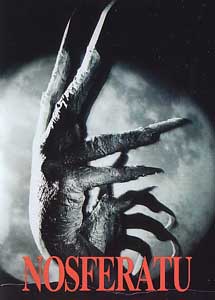

 As Harker is taken to the mountain castle in a devil's carriage, the Club Foot Orchestra gave it a rapid tinky-tinkle score more suited to Tom & Jerry cartoons.
As Harker is taken to the mountain castle in a devil's carriage, the Club Foot Orchestra gave it a rapid tinky-tinkle score more suited to Tom & Jerry cartoons. Nor is subtlety a hallmark of silent movies generally, & Max Schrek as Dracula (renamed Graf Orlok) could no more pass for human than could a giant rat, which he in part seems to be.
Nor is subtlety a hallmark of silent movies generally, & Max Schrek as Dracula (renamed Graf Orlok) could no more pass for human than could a giant rat, which he in part seems to be.
 Bruno Ganz as Jonathan Harker is way more interesting in this version, & Isabella Adjani as Lucy Harker (again compounded with Mina) is way more thrilling & sexy than was Greta Schroeder in the role as Nina/Ellen.
Bruno Ganz as Jonathan Harker is way more interesting in this version, & Isabella Adjani as Lucy Harker (again compounded with Mina) is way more thrilling & sexy than was Greta Schroeder in the role as Nina/Ellen.
 Shadow of the Vampire assumes that the rumors about Max Schreck were true.
Shadow of the Vampire assumes that the rumors about Max Schreck were true. He takes the character created by history's Max Schreck & gives him another, fuller existence apart from the film in which Murnau has cast him.
He takes the character created by history's Max Schreck & gives him another, fuller existence apart from the film in which Murnau has cast him.